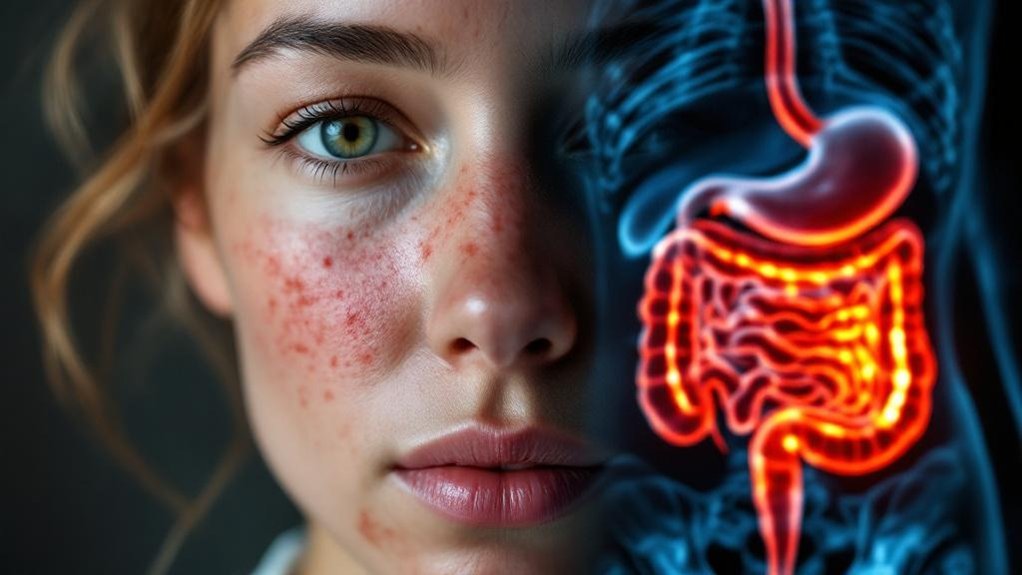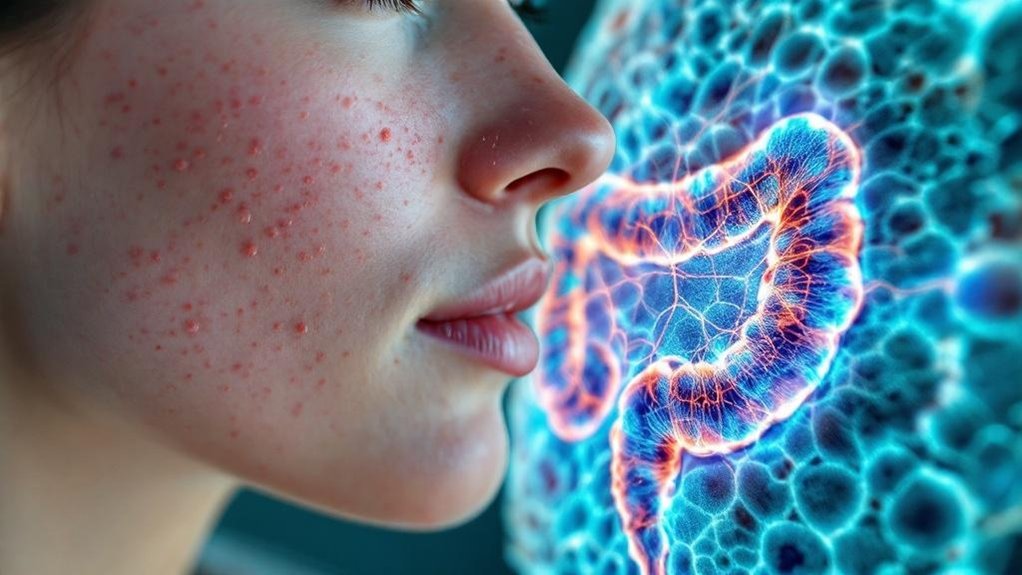Posted by: Skin And Cancer Institute in Medical Dermatology

Recent research confirms a strong bidirectional connection between gut health and rosacea. We’re seeing compelling evidence that gut microbiome imbalances, particularly conditions like SIBO (present in up to 90% of rosacea patients), trigger systemic inflammation that manifests as facial redness and bumps. The gut-skin axis involves immune, neural, and inflammatory pathways that directly influence rosacea symptoms. Understanding these connections opens the door to more effective integrative treatment approaches.
Key Takeaways
- Studies reveal that 50-90% of rosacea patients have small intestinal bacterial overgrowth (SIBO).
- Gut dysbiosis triggers systemic inflammation that can directly exacerbate rosacea symptoms.
- Leaky gut allows inflammatory compounds and bacterial toxins to enter circulation, manifesting as facial redness.
- Successful treatment of gut conditions with antibiotics can lead to significant or complete rosacea remission.
- The gut-skin axis creates bidirectional communication through immune, neural, and inflammatory pathways.
Understanding the Gut-Skin Axis: A Scientific Overview

While researchers have long observed correlations between skin conditions and digestive health, recent scientific evidence has established a bidirectional communication system known as the gut-skin axis.
This complex pathway involves immune cells, neural connections, and systemic inflammatory mediators that allow gut microbiota to influence skin health.
At our practice, we’ve observed how disruptions in this balance often manifest in inflammatory skin conditions like rosacea. Gut dysbiosis can trigger systemic inflammation that compromises skin hydration and barrier function, exacerbating rosacea symptoms.
Interestingly, this connection isn’t purely physiological. Emotional triggers affect both gut function and skin reactivity through shared neuroendocrine pathways.
We’re exploring how stress management techniques might benefit our patients by simultaneously addressing both gut health and rosacea flares.
We believe this integrated approach offers promising new treatment avenues. Our dermatologists at The Skin and Cancer Institute Gilbert are dedicated to creating personalized treatment plans that address both skin manifestations and underlying gut health factors.
Common Gut Disorders Associated With Rosacea Flare-Ups
At our practice, we’ve consistently observed specific digestive disorders that correlate with rosacea symptom intensity.
Research indicates that small intestinal bacterial overgrowth (SIBO), irritable bowel syndrome (IBS), and inflammatory bowel disease often coincide with rosacea flare-ups. These conditions create systemic inflammation that manifests on the skin.
Hormonal balance plays a pivotal role in this relationship, as gut dysbiosis can disrupt endocrine function, potentially worsening rosacea symptoms during hormonal fluctuations.
Additionally, stress management becomes essential, as psychological stress alters gut permeability and microbiome composition.
Our patients with both rosacea and digestive issues report improvement when addressing gut health through targeted interventions.
Proper skin protection using broad spectrum protection sunscreens is also crucial for rosacea patients, as UV exposure can trigger inflammatory responses that exacerbate symptoms.
Gut Microbiome Imbalances and Their Impact on Skin Inflammation

Microbiome imbalances, known as dysbiosis, can trigger systemic inflammation that manifests on the skin as rosacea flares.
We’ve observed that Small Intestinal Bacterial Overgrowth (SIBO) occurs at substantially higher rates in rosacea patients, suggesting a direct relationship between gut bacteria and facial inflammation.
Increased intestinal permeability, or “leaky gut,” allows inflammatory compounds to enter the bloodstream, creating a pathway through which gut dysfunction can directly influence skin health.
For complex skin conditions like rosacea, our board-certified dermatologists at Skin and Cancer Institute in Lake Havasu offer personalized treatment plans that address both symptoms and potential gut-related causes.
Dysbiosis Triggers Inflammation
Research increasingly points to the pivotal role of gut dysbiosis—an imbalance in the intestinal microbial community—in triggering systemic inflammation that can manifest as rosacea symptoms.
When gut dysbiosis occurs, the intestinal barrier function becomes compromised. This allows bacterial products and inflammatory molecules to enter the bloodstream.
This systemic inflammation can then activate immune responses in the skin of individuals with a genetic predisposition to rosacea. We’re discovering that these inflammatory pathways are particularly sensitive to environmental triggers such as certain foods, stress, and temperature changes.
At our practice, we’re seeing how addressing gut health can notably improve rosacea outcomes.
The gut-skin axis represents a promising therapeutic avenue, as restoring microbial balance may reduce inflammatory cascades that contribute to the characteristic redness, bumps, and irritation of rosacea.
SIBO and Rosacea
Small intestinal bacterial overgrowth (SIBO) has emerged as a significant factor in rosacea pathophysiology, with studies demonstrating that 50-90% of rosacea patients have concurrent SIBO diagnoses. This striking correlation suggests a direct mechanistic link between gut microbiome disruptions and skin inflammation patterns.
When bacteria typically confined to the large intestine proliferate in the small intestine, they produce gases and inflammatory compounds that can trigger systemic effects.
For patients experiencing persistent rosacea triggers and skin sensitivity despite topical treatments, we recommend evaluating for potential SIBO.
Research indicates that successful SIBO treatment with appropriate antibiotics often leads to dramatic improvement in rosacea symptoms, sometimes achieving complete remission.
This gut-skin connection emphasizes the importance of addressing internal factors rather than focusing exclusively on external management strategies.
Leaky Gut Connection
The integrity of the intestinal barrier plays a fundamental role in the rosacea-gut relationship, complementing our understanding of SIBO’s influence. When this barrier becomes compromised—a condition commonly referred to as “leaky gut”—intestinal permeability increases, allowing bacterial endotoxins and food antigens to enter systemic circulation.
This process triggers immune responses that manifest as skin inflammation.
At our practice, we’ve observed how these inflammatory mediators can exacerbate rosacea symptoms. Studies suggest that addressing gut barrier function often correlates with improved skin appearance.
We recommend an integrated approach that includes anti-inflammatory foods, proper skin hydration protocols, and occasional use of tea tree formulations for their antimicrobial properties.
Together, we’ll develop a personalized treatment plan that addresses both your gut health and skin manifestations, recognizing that skin health often reflects internal equilibrium.
The Role of Intestinal Permeability in Rosacea Development

Contrary to popular belief, evidence supporting the direct connection between intestinal permeability and rosacea remains limited and inconclusive.
While some patients report improvements in rosacea symptoms after addressing gut health, the scientific literature doesn’t yet provide robust validation of this relationship.
The hypothesis centers on disruptions to tight junctions in the intestinal lining, which may allow inflammatory compounds to enter circulation.
These compounds could potentially trigger or worsen skin inflammation characteristic of rosacea.
Additionally, alterations in microbial diversity within the gut microbiome have been observed in some rosacea patients, suggesting a possible pathway between intestinal health and skin manifestations.
We’re closely following emerging research in this area, as understanding these connections could lead to innovative treatment approaches for our rosacea patients.
At the Skin and Cancer Institute in Lodi, our board-certified dermatologists provide comprehensive evaluations to determine the most effective treatment approach for your rosacea symptoms.
Dietary Modifications That Support Both Gut and Skin Health
We recommend prioritizing anti-inflammatory foods to reduce rosacea flares while simultaneously supporting gut health.
Incorporating fiber-rich prebiotic foods such as leafy greens, artichokes, and legumes nourishes beneficial gut bacteria that help maintain intestinal barrier function.
These dietary modifications can effectively address both conditions by reducing systemic inflammation and promoting microbial diversity in the gut microbiome.
Our board-certified dermatologists can develop personalized treatment plans that address both your skin condition and dietary needs.
Anti-inflammatory Foods First
Because gut health and skin inflammation are closely connected, making strategic dietary modifications can simultaneously address both rosacea symptoms and intestinal dysbiosis.
We recommend prioritizing anti-inflammatory foods that reduce systemic inflammation while supporting your microbiome.
Incorporate omega-3 rich foods like wild salmon and flaxseeds, which combat inflammatory pathways affecting both gut and skin.
Polyphenol-containing foods—berries, green tea, and olive oil—provide antioxidant protection against environmental toxins that can trigger rosacea flares.
Prebiotics found in fiber-rich vegetables nourish beneficial gut bacteria, while fermented foods introduce diverse probiotics that strengthen intestinal barriers.
Your seasonal skincare routine should complement these dietary changes, as external irritants can compound internal inflammation.
Track your response to these modifications, as individual triggers vary markedly among rosacea patients.
Fiber-rich Prebiotic Powerhouses
Prebiotics serve as the essential foundation for a thriving gut microbiome, ultimately influencing rosacea management through their ability to nourish beneficial bacterial populations.
We recommend incorporating diverse prebiotic-rich foods into your daily diet to support both intestinal and skin health. Foods like garlic, onions, leeks, asparagus, and Jerusalem artichokes contain inulin, which promotes fiber fermentation by beneficial bacteria.
Prebiotic diversity matters considerably—different fibers feed various bacterial strains, creating a more balanced microbiome. Aim for 25-30 grams of fiber daily through a colorful array of plant foods.
Resistant starches found in cooled potatoes, green bananas, and oats also serve as excellent prebiotic sources.
When our patients gradually increase their prebiotic intake, they often report improvements in both digestive function and rosacea symptoms within 4-6 weeks.
Probiotics and Supplements: Evidence-Based Recommendations

While research exploring the relationship between gut health and rosacea continues to evolve, evidence-based recommendations for probiotics and supplements remain limited. Our clinical observations suggest that certain strains, particularly Lactobacillus and Bifidobacterium species, may help reduce inflammatory markers associated with rosacea flares.
When considering digestive support, enzyme supplements containing protease, amylase, and lipase might improve nutrient absorption and reduce intestinal inflammation that potentially triggers skin manifestations.
Additionally, herbal extracts such as turmeric (curcumin) and ginger demonstrate promising anti-inflammatory properties in preliminary studies.
We recommend consulting with your dermatologist before starting any supplement regimen, as individual responses vary notably.
Our team can help develop a personalized approach that integrates gut health strategies with traditional rosacea treatments for potentially better outcomes. Our board-certified dermatologists at The Skin and Cancer Institute in Stevenson Ranch provide expert, personalized treatments for various skin conditions including rosacea.
Integrative Treatment Approaches: Combining Conventional and Gut-Focused Therapies
Integrating conventional rosacea treatments with gut-focused interventions offers a holistic approach that addresses both cutaneous symptoms and potential underlying triggers.
At Skin and Cancer Institute, we recognize that effective management often requires combining topical therapies and oral antibiotics with dietary modifications and gut microbiome support.
Our dermatologists consider both genetic predispositions and environmental triggers when developing personalized treatment plans.
We may recommend targeted probiotics alongside traditional medications, particularly for patients with concurrent digestive symptoms.
Additionally, we often suggest anti-inflammatory diets while monitoring skin responses.
This all-inclusive strategy acknowledges the gut-skin axis’s significance while maintaining evidence-based dermatological care.
We’re committed to exploring all avenues that might benefit our patients, including emerging research on how intestinal dysbiosis may exacerbate inflammatory skin conditions like rosacea.
For patients with Medicaid coverage, our board-certified dermatologists provide comprehensive treatment options that integrate both conventional approaches and emerging gut health therapies.
Frequently Asked Questions
Can Stress Make Both Rosacea and Gut Problems Worse?
Yes, stress can exacerbate both rosacea and gut issues. We’ve observed the gut-rosacea link in clinical practice. Effective stress management techniques are essential components of our thorough treatment approach for these interconnected conditions.
Are Topical Treatments Less Effective if Gut Issues Remain Untreated?
Yes, topical treatments may have reduced efficacy when gut issues persist. The gut microbiome influences skin inflammation pathways, so addressing both can provide more extensive relief for our rosacea patients.
How Long Before Dietary Changes Improve Rosacea Symptoms?
We typically observe improvements within 4-6 weeks of dietary changes. Don’t forget hydration importance for maintaining your skin barrier function while addressing gut-related rosacea triggers alongside our community.
Can Food Sensitivity Testing Help Identify Rosacea Triggers?
Yes, food sensitivity testing can help identify potential rosacea triggers. We find these tests valuable for detecting food allergens that may impact digestive health and subsequently affect your skin’s inflammatory response.
Is Rosacea More Difficult to Treat in Patients With IBS?
Yes, patients with IBS often experience more challenging rosacea treatment due to overlapping gut-skin microbiome disruptions. We’ve observed that hormonal influence compounds these difficulties in our practice with these interconnected conditions.
Conclusion
We’ve examined the bidirectional relationship between gut health and rosacea through our clinical observations. The evidence demonstrates that intestinal dysbiosis, increased permeability, and systemic inflammation directly influence cutaneous manifestations. By implementing targeted interventions addressing both dermatological symptoms and gastrointestinal function, we’re achieving superior therapeutic outcomes. Our integrated approach underscores the necessity of treating the gut-skin axis holistically rather than addressing these systems in isolation.